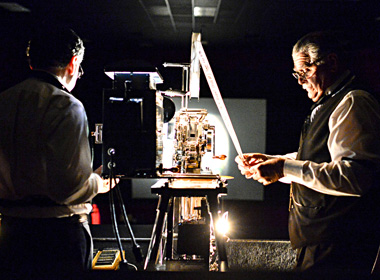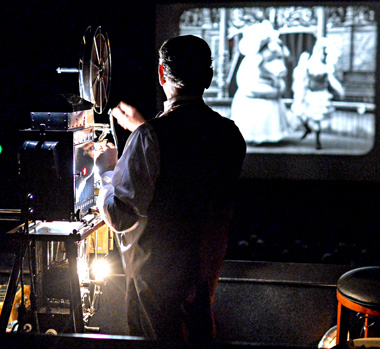
Step into the time machine for hand-cranked projection of silent shorts
Screened at the TCM Film Festival, March 28, 2015
By Mary McCord, Editor, classicfilmwatch.com
The Academy of Motion Picture Arts and Sciences' presentation, Return of the Dream Machine, turned out to be a time machine of sorts. The collection of short, silent films from 1902-1913 were presented using hand-cranked projection, the same technology used in the early 1900s. There was even an exciting, surprise ending to the show, treating the audience to the first showing of a newly-restored short film.
The program included some of the most famous early films, including A Trip to the Moon (1902), The Great Train Robbery (1903) and Little Nemo (1911). I was very familiar with A Trip to the Moon, having seen it at the 2012 TCM Classic Film Festival and remember clips from the film that appeared in the 2011 Martin Scorsese film, Hugo.
Randy Haberkamp, Managing Director of Preservation and Foundation Programs for the Academy, introduced the eight films and spoke about the technology that was being used. He said the rate of speed of the hand-cranking had to be at the same rate of speed used by the camera operators who filmed the movies.
It was a memorable experience to view these early classics the same way an audience did when they were first screened. It was fascinating to look at the back of the theater and see Joe Rinaudo, assisted by Gary Gibson, both in costumes of the time period, tirelessly operating a 1909 Hand-Crank Power's Model 6 Cameragraph Motion Picture Machine.
The entertainment and the trip back in time included pre-show music played by Galen Wilkes on a 1908 Edison Phonograph. No electricity was used to operate it, but a microphone was needed to make the sound loud enough to be heard in the theatre.
During the screenings, live musical accompaniment was provided by Michael Mortilla.
At the end of the scheduled short films, Rinaudo announced they had a surprise for the audience. He and Gibson had been working on restoration of a film clip that was finished just before the show began. The surprise was a beautiful, hand-colored, serpentine dance from over 100 years ago.
The whole show was unique, entertaining and even historical with the screening of the surprise film that had never been seen before. Read more about the films below.
A Trip to the Moon (Le Voyage dans la Lune) is a 1902 French silent film directed by Georges Méliès. Some of the inspiration for the film came from Jules Verne’s novels, From the Earth to the Moon and Around the Moon. The film’s story centers around a group of astronomers, who travel to the moon in a capsule propelled by a cannon. During their exploration of the moon’s surface, they escape from an underground group of lunar inhabitants called Selenites. They capture a Selenite and return to Earth with a splashdown. It features a cast of French theatrical actors, led by Méliès himself in the main role of Professor Barbenfouillis. The film was an international success upon its release, especially in the United States. Today, it is widely thought to be the earliest example of the science fiction film genre. Some prints of A Trip to the Moon were hand-colored by a Parisian coloring lab. An original hand-colored print was discovered in

1993 and restored in 2011 by film historian, Serge Bromberg. It was shown at the Cannes Film Festival shortly afterwards and then at the TCM Classic Film Festival in 2012. Clips of A Trip to the Moon appear in the 2011 Martin Scorsese film, Hugo, which includes the character of the director, Méliès.
The Great Train Robbery (1903) is an American, silent Western, 10-minute short film written, produced and directed by Edwin S. Porter. This film is considered a milestone in film making. It used a number of innovative techniques, including composite editing, camera movement and on location shooting. The film is one of the earliest to use the technique of cross cutting in which two scenes appear to occur simultaneously, but in different locations. The Great Train Robbery is now considered to be the first American action film and the first western film. With a budget of $150, the film was one of the first blockbusters and one of the most popular films of the silent era.
Little Nemo, also known as Winsor McCay, the Famous Cartoonist of the N.Y. Herald and His Moving Comics is a 1911 silent, animated short film. It was Winsor McCay’s first animated film and one of the earliest. It featured characters from McCay’s comic strip Little Nemo in Slumberland. Its expressive character animation distinguished the film from the experiments of earlier animators. Inspired by flip books his son brought home, McCay came to see the potential of the animated film medium. Little Nemo is still a well-known character. A joint American-Japanese feature-length film, Little Nemo: Adventures in Slumberland appeared in 1989 followed in 1990 by a video game adaptation of the 1989 film titled Little Nemo: The Dream Master.
Those Awful Hats (1909), American silent, short comedy film directed by D. W. Griffith, takes place in a small, crowded theatre. The movie-goers are constantly distracted by women wearing very large hats that obstruct everyone else’s views of the screen.
The Four Troublesome Heads (Un homme de tetes) is an 1898 French silent, short film directed by Georges Méliès. The film features the first known use of multiple exposure of objects on a black background on film, a special effect Méliès later used to a great extent. A print of the film, copied without authorization from Méliès, was released in the U.S. in 1903.
A Corner in Wheat (1909), is an American silent, short film which tells the story of a greedy businessman who tries to corner the world market on wheat. This leads to the destruction of people’s lives who can no longer afford to buy bread. It was directed by D. W. Griffith. The film was based on the book, The Pit, by Frank Norris. It was also released on 8mm in the 1960s.
Suspense (1913) is an American silent, short film thriller directed by Phillips Smalley and Lois Weber. A man is working late when a tramp breaks into his home where his wife and their baby are alone. His wife phones him as the tramp is breaking in and, horrified, he steals a car and races home with the police chasing him. In the meantime, the tramp, carrying a large knife, is breaking through the door to the room where the wife has locked herself and her baby. The film features an early example of a split screen shot.
Le Cochon (The Dancing Pig) is a silent, four-minute, burlesque film based on a Vaudeville act. It was released in 1907 by Pathe, a French company. In the film, a giant pig dressed in human, fancy clothes, dances with a girl, who later embarrasses him by tearing his clothes off.
